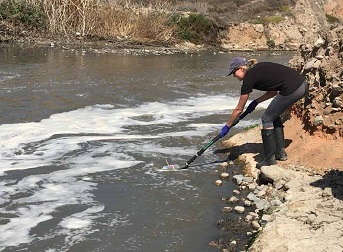DNA-based community fingerprinting used to link Mexican sewage to U.S. beach pollution

SCCWRP and its partners have tracked sewage from a wastewater treatment plant in Mexico to south San Diego County beach water – a proof-of-concept study that illustrates the power of using a next-generation, DNA-based technology known as community fingerprinting for linking fecal contamination to specific sources.
During the cross-border study, which was published online in provisional form by the journal Frontiers in Microbiology in July, researchers found that the genetic microbial community signature of a Tijuana treatment plant is also present along a 12-mile stretch of coastline spanning the U.S.-Mexico border.
The fecal contamination follows a predictable dilution gradient that is consistent with south swell ocean currents. The San Antonio de Los Buenos treatment plant discharges partial primary-treated effluent through a Tijuana outfall to the coastal ocean.
The study’s main conclusions are consistent with the findings of a research team at the Scripps Institution of Oceanography that used an ocean currents model to show that the Tijuana wastewater plume could be reaching San Diego beaches during south swell events.
The three-year study marks one of the first efforts in Southern California to use DNA-based community fingerprinting technology to differentiate among specific infrastructure sources where human fecal contamination could be originating.
Community fingerprinting involves looking for unique overall genetic patterns in the microbial community associated with specific sources or types of infrastructure, such as treatment plants, sewer pipes and storm drain pipes. When these genetic signatures are detected downstream, researchers can use the signal to link fecal contamination to a specific source.
SCCWRP and its partners are applying the same community fingerprinting approach to help investigate whether the human fecal contamination found in San Diego-area waterways can be linked to sanitary sewer pipes; this study is ongoing.
The cross-border study was motivated by reports from beachgoers and lifeguards at Imperial Beach – just north of the border – about persistent sewage odors during south swell events.
During the study – completed in partnership with the U.S. Environmental Protection Agency and the County of San Diego, among others – beach water samples were collected along a 12-mile stretch of coastline on summer days when coastal swells travel south to north. Researchers analyzed the samples to look for the genetic signature found at the Tijuana treatment plant; they also used the HF183 genetic marker to confirm that the fecal contamination was from a human source.
Researchers were able to detect similar trends using both the community fingerprinting and HF183 analyses, measuring the contamination gradient as far north as Silver Strand State Beach, which is north of Imperial Beach and about 15 miles north from the Tijuana treatment plant outfall.
The cross-border study has served to help validate decisions by public health officials in Imperial Beach to routinely post beach advisories during south swell events. The study’s findings also have helped inform more focused conversations in Mexico about how to reduce fecal pollution loading from the Tijuana treatment plant.
For more information, contact Dr. Amy Zimmer-Faust.
More news related to: Microbial Source Tracking, Microbial Water Quality, Top News